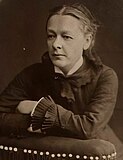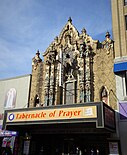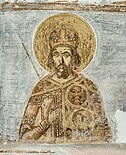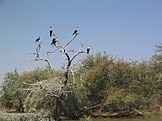Wikipedia:Main Page history/2025 January 6
From today's featured article
Maria Trubnikova (6 January 1835 – 28 April 1897) was a Russian feminist and activist. From a wealthy family, she was orphaned at a young age and raised by her aunt. She married Konstantin Trubnikov at the age of 19; they had seven children. Trubnikova hosted a women-only salon which became a center of feminist activism. Alongside Anna Filosofova and Nadezhda Stasova, whom she mentored, Trubnikova was one of the earliest leaders of the Russian women's movement; the three women were referred to as the "triumvirate". They founded several organizations designed to promote women's cultural and economic independence, as well as pushing for higher education for women. Trubnikova maintained international connections to fellow feminists in England, France, and other countries. Over time, her once-liberal husband grew implacably opposed to her activism, and they separated. Trubnikova later experienced severe illness; she died in an asylum in 1897. (Full article...)
Did you know ...
- ... that New York City's Valencia Theatre (pictured) was sold to a church in 1977 for $1?
- ... that the murder of skier Corinne Rey-Bellet led to a change in Swiss gun-control regulations?
- ... that Home and Beauty has been described as both a "little masterpiece of polite merriment" and a "misogynist comedy dipped in vitriol"?
- ... that Bea Hines, the first African-American woman to become a reporter at the Miami Herald, was sent to report on a riot on her first day at work?
- ... that terracotta cones found at al-Moghraqa in Palestine are unique in the region, but resemble artefacts from ancient Egypt?
- ... that Yvonne Francis-Gibson, before improving women's rights as a legislator in Saint Vincent and the Grenadines, led a Women's Desk that was "unable to take a firm stand on behalf of women's issues"?
- ... that Aquilegia moorcroftiana is named after a mountaineer and is found at the highest elevation of any species of columbine?
- ... that the U.S. Centers for Disease Control and Prevention was just one center until 1980?
- ... that Yuki Waga created the "earworm" for "Shikairo Days" by walking around his house repeating "shikanoko nokonoko koshitantan"?
In the news
- Luke Littler (pictured) wins the PDC World Darts Championship.
- A spree shooter in Cetinje, Montenegro, kills 12 people and injures 4 others.
- Romania and Bulgaria become full members of the Schengen Area.
- In New Orleans, an attacker rams a truck into a crowd and opens fire, killing at least 14 people and injuring 35 others.
On this day
- 1449 – Four years before the fall of Constantinople, Constantine XI Palaiologos (pictured) assumed the throne as the last Byzantine emperor.
- 1725 – J. S. Bach led the first performance of Liebster Immanuel, Herzog der Frommen, a chorale cantata for Epiphany.
- 1912 – German geophysicist Alfred Wegener presented his theory of continental drift, the precursor of plate tectonics, to the German Geological Society.
- 1953 – The inaugural Asian Socialist Conference, an organisation of socialist political parties, opened in Rangoon with 177 delegates, observers and fraternal guests.
- 2014 – The first episode of the documentary series Benefits Street aired on Channel 4, prompting discussion in the United Kingdom about welfare dependency.
- Baltasar Hidalgo de Cisneros (b. 1756)
- Earl Scruggs (b. 1924)
- Babrak Karmal (b. 1929)
- Sybil Plumlee (d. 2012)
From today's featured list
There are seven World Heritage Sites in Senegal as of 2025, with a further eight on the tentative list. The United Nations Educational, Scientific and Cultural Organization (UNESCO) World Heritage Sites are places of importance to cultural or natural heritage as described in the UNESCO World Heritage Convention, established in 1972. The first site in Senegal to be inscribed to the list was the island of Gorée, in 1978. The most recently designated site is the Bassari Country, in 2012. Five sites in Senegal are listed for their cultural properties, and two for their natural properties. The Djoudj National Bird Sanctuary (pictured) was twice placed on the List of World Heritage in Danger, from 1984 to 1988 and from 2000 to 2006; the first time because of the risks posed by the planned construction of a dam downstream, and the second time because of the spread of the invasive plant Salvinia molesta. (Full list...)
Today's featured picture

|
The Cathedral of La Laguna is a Roman Catholic church in San Cristóbal de La Laguna, on the Spanish island of Tenerife in the Canary Islands. The church was designated a cathedral in 1818 and is the seat of the Diocese of San Cristóbal de La Laguna, which includes the islands of Tenerife, La Palma, La Gomera and El Hierro. The current building was constructed between 1904 and 1915 to replace an earlier building begun in 1515. The cathedral is located in the historic centre of La Laguna and was declared a World Heritage Site in 1999 by UNESCO. It contains elements of several architectural styles and is noted for its Neoclassical facade, inspired by Pamplona Cathedral, as well as its dome, which stands out prominently in the city landscape. In the cathedral lie the remains of Alonso Fernández de Lugo, the conqueror of the island and founder of the La Laguna. This photograph shows one of the side chapels of the Cathedral of La Laguna, with a 6-metre-tall (20 ft) gilded reredos behind the altar. Constructed in the Baroque style in the first half of the 18th century, the reredos is the largest in the Canary Islands. The chapel is dedicated to the Virgin of Los Remedios, whose statue is in the central niche behind the altar. The reredos features seven paintings, attributed to Hendrick van Balen, depicting scenes from the lives of Jesus and Mary. Photograph credit: Diego Delso
Recently featured:
|
Other areas of Wikipedia
- Community portal – The central hub for editors, with resources, links, tasks, and announcements.
- Village pump – Forum for discussions about Wikipedia itself, including policies and technical issues.
- Site news – Sources of news about Wikipedia and the broader Wikimedia movement.
- Teahouse – Ask basic questions about using or editing Wikipedia.
- Help desk – Ask questions about using or editing Wikipedia.
- Reference desk – Ask research questions about encyclopedic topics.
- Content portals – A unique way to navigate the encyclopedia.
Wikipedia's sister projects
Wikipedia is written by volunteer editors and hosted by the Wikimedia Foundation, a non-profit organization that also hosts a range of other volunteer projects:
-
Commons
Free media repository -
MediaWiki
Wiki software development -
Meta-Wiki
Wikimedia project coordination -
Wikibooks
Free textbooks and manuals -
Wikidata
Free knowledge base -
Wikinews
Free-content news -
Wikiquote
Collection of quotations -
Wikisource
Free-content library -
Wikispecies
Directory of species -
Wikiversity
Free learning tools -
Wikivoyage
Free travel guide -
Wiktionary
Dictionary and thesaurus
Wikipedia languages
This Wikipedia is written in English. Many other Wikipedias are available; some of the largest are listed below.
-
1,000,000+ articles
-
250,000+ articles
-
50,000+ articles





